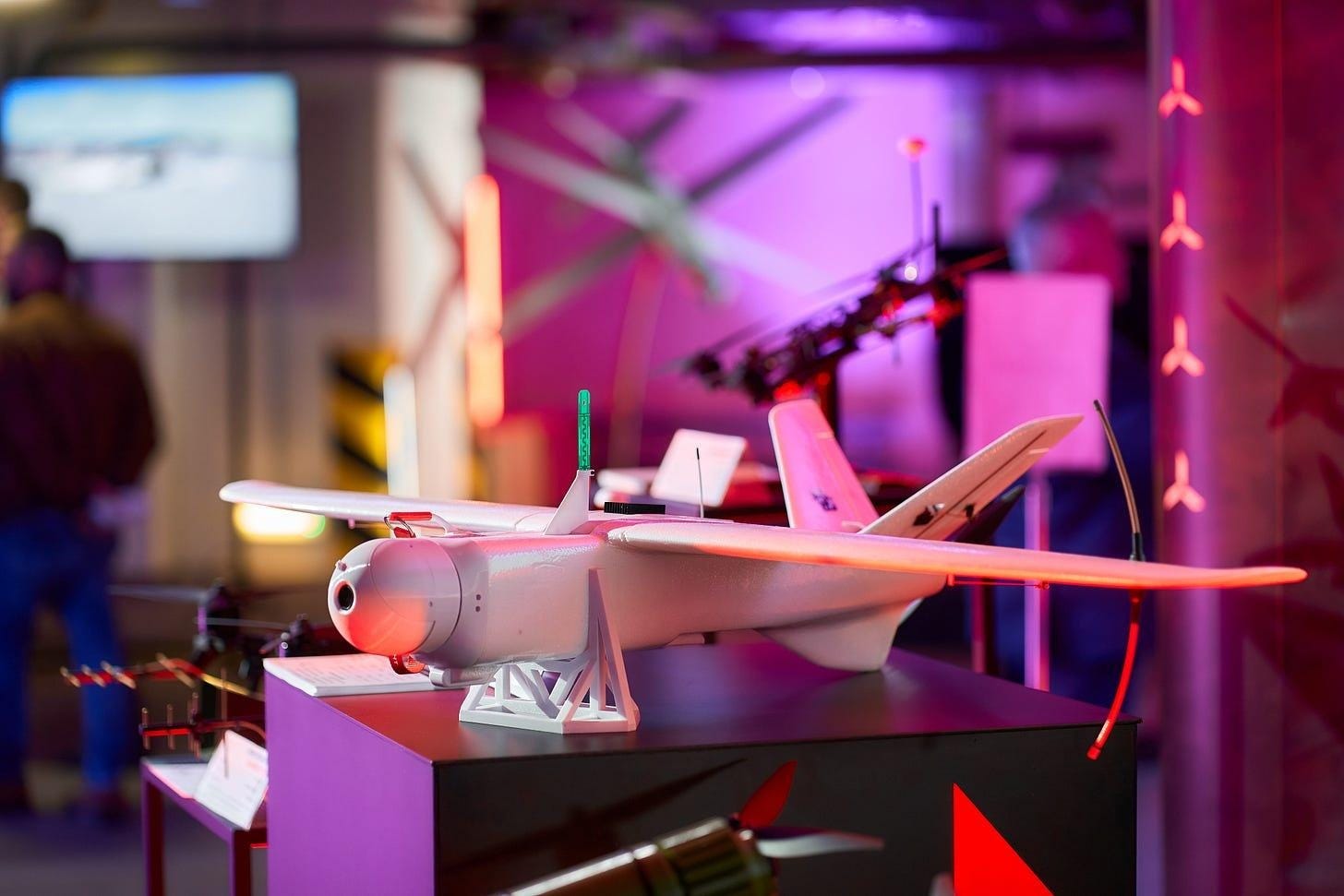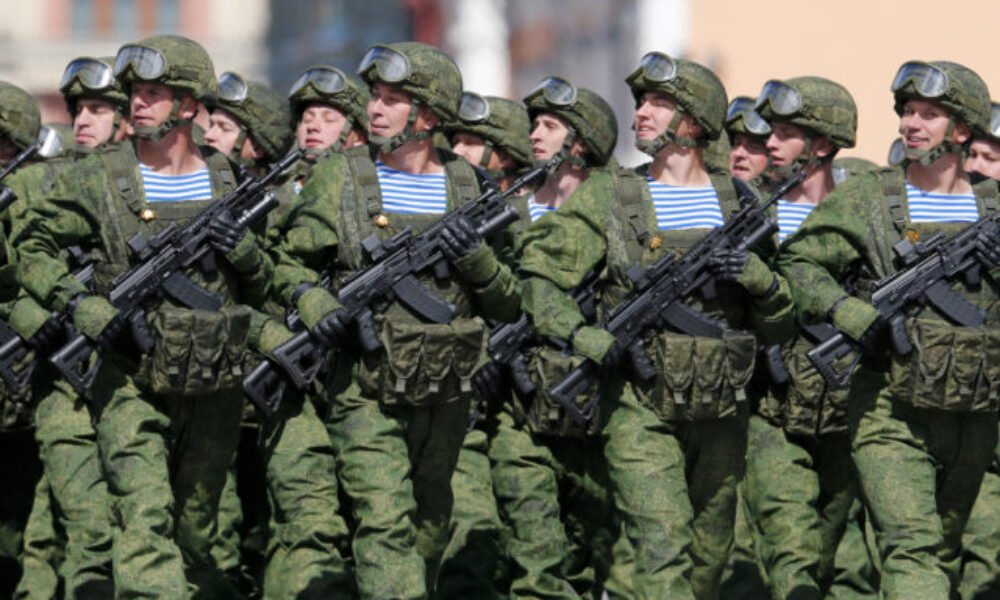
“Every half an hour, TAF Industries upgrades one Kolibri FPV drone to keep it relevant on the battlefield.” That’s what I read just before my interview with TAF Industries founder and CEO Oleksandr Yakovenko.
How is that possible, I wondered, given claims that FPV drones have already reached the peak of their development? I began our conversation with this question, and we went on to discuss many important topics — from fiber-optic drones to the crucial role of pilot skills.
TAF Industries is one of the largest producers of FPV drones in Ukraine, with a monthly output of around 80,000 systems. Their analysis of the current state of drone warfare in Ukraine is something everybody should read.
Just a reminder: my publications are not sponsored. This digest is supported only by private individuals — readers and subscribers like you.
In 2025, TAF Drones rebranded as TAF Industries — a group that now unites five companies across different defence-tech sectors.
Currently, TAF includes: a company responsible for importing components; a producer of electronic warfare (EW) and electronic intelligence (ELINT) systems; a manufacturer of reconnaissance drones; a company specializing in the production of FPV drones; and a software developer, focusing on targeting systems, communication technologies, and related solutions.
Founded at the end of 2023, the company grew from a team of 20 to a staff of about 1,000 and an annual turnover approaching $500 million.
Currently, TAF Industries produces up to 80,000 drones per month and already has agreements to set up two joint production lines in foreign countries. Under one of these deals, the partner will effectively invest $10 million into TAF Industries.
Before Russia’s full-scale invasion of Ukraine, TAF Industries founder Oleksandr Yakovenko worked in logistics, fuel import, and grain export. Starting from February 2022, his logistics vehicles were used by the Armed Forces of Ukraine to transport heavy equipment and ammunition.
While assisting the Ukrainian military over the course of the year, Oleksandr opened an experimental joint drone production with the National Guard of Ukraine, which launched in August 2023. Unfortunately, a sabotage operation at the military facility destroyed that production line and its warehouse stock, forcing the team to start from scratch.
In December 2023, TAF Industries launched a new production line with an initial capacity of roughly 2,000 units per month.
Today, TAF produces up to 80,000 Kolibri FPV drones per month, as well as other products, depending on order volume and costs. “We could easily produce 150,000 drones, but the state’s procurement resources are limited,” the company says.
According to Oleksandr’s calculations, Ukraine currently needs 6-8 mln FPV drones annually.
Kolibri FPV Drones
Kolibri (Hummingbird) FPV drone is TAF Industries’ flagship product.
The first and most popular model is the Kolibri 7: praised for its compactness, quick setup, and manoeuvrability, with an operational ceiling of up to 3 km. It can carry a warhead of 1.5 kg for up to 15 minutes; at cruising speeds of 60–80 km/h, its tactical radius is about 12 km.
The Kolibri 8 differs in size and range from its predecessor, performing missions out to 14 km. Also, it supports FPV operation with optional AI-assisted targeting guidance (Last Mile), remote delayed-start (PowerKey), and a choice of analog, digital, or thermal video solutions.
The Kolibri 10 — rugged strike drone has a 12,600 mAh battery, 2.4 kg warhead capacity, and a thermal variant for night ops. It operates on MilELRS firmware, ensuring stable performance under intense EW conditions. Support for non-standard video frequencies allows the drone to adapt to specific mission requirements.
Maintaining communications in complex terrain and under active electronic warfare remains one of the key challenges on the battlefield, so TAF Industries has started production of the Kolibri 13 FR1 repeater. The new platform was unveiled in autumn 2025. The company says its solution is half the cost of a comparable DJI Matrice-based system, comes ready to use out of the box, and requires only one day of operator training. In effect, it is a relay platform that preserves communications on the battlefield where difficult terrain and numerous interference sources degrade links — a capability that is critical for situational awareness and for employing other unmanned systems. Advantages of the Kolibri 13 FR1 include daytime and nighttime operation and optical stabilization that removes the need for GPS.
Due to the constant battlefield changes, drones quickly lose effectiveness — which is why TAF Industries has been upgrading Kolibri FPV drones for three months now, having already processed almost 5,000 units. TAF receives upgrade requests directly from the brigades and carries out the modernization at its own expense.
In response to my question, if it’s still possible to further improve FPV drones, Oleksandr replied that FPV drones are constantly being upgraded. “Although at first glance an FPV drone seems like a simple and inexpensive platform, frontline experience shows that even small technical adjustments can significantly change how it is used,” he added.
Key points important in this process:
-
Practical feedback from the front line. Soldiers and operators provide real-time feedback, which drives the evolution of both designs and tactics of use.
-
Low production cost is a major advantage. “Even an additional $7–9 circuit board can significantly expand the functionality without moving the platform out of the “cheap and scalable” category,” Oleksandr says.
-
Tactical innovations in use. An FPV drone launched in close proximity to the enemy can save battery power (in certain modes, it consumes no energy until detection), and the operator activates it at the right moment — this changes how it is deployed.
-
Autonomy and modularity. Developers are creating “guidance” modules and other auxiliary blocks: step by step, drones are becoming more autonomous and expanding the range of tasks they can perform independently.
-
Continuous incremental improvements. There is no need for a “revolution” — numerous small upgrades (more reliable motors, better control boards, stronger communication links, improved targeting modules, and weather protection) collectively enhance performance.
-
Reliability in harsh conditions. The next iterations will factor in performance in rain and humid environments, ensuring full waterproofing.
“FPV platforms still hold enormous potential for improvement — not through one major breakthrough, but through continuous, field-driven refinements of hardware, software, and tactics, guided by direct feedback from users on the battlefield,” commented Oleksandr.
It’s now well documented that cheap FPV drones are destroying traditional systems, like tanks and armoured vehicles, as well as expensive enemy drones. In July 2025, a Kolibri FPV drone costing around $400 took down a Russian Lancet reconnaissance drone worth approximately $30,000–35,000.
Recently, in October 2025, a $500 worth Kolibri FPV drone fitted with a thermal camera struck a Russian BM-21 multirocket launcher. Each BM-21 Grad unit costs roughly $2.5 million to produce, with each shot fired by the BM-21 costing approximately $3,000.
Fiber-Optic Drones
In September 2025, TAF Industries reported the codification of Kolibri 13 O fiber-optic variant. The fiber-optic Kolibri’s strengths are full protection against EW and interception thanks to the fiber cable, an integrated media converter for quick setup, and the stability and precision required for planning strikes.
Their technical characteristics:
-
Payload — up to 3 kg
-
Tactical range — 14 km
-
Cruise speed — 60–80 km/h
-
Flight altitude — up to 200 m
-
Fiber-optic cable length — 17 km
-
Endurance — 17 minutes
-
Day/night camera
-
Battery — from 16,000 mAh
The founder of TAF Industries is convinced that fiber-optic drones will certainly remain with us — they are a versatile tool for short- and medium-range combat.
In an interview with Ukraine’s Arms Monitor, Oleksandr outlined many of their key characteristics, which can be summarized as follows:
-
Their main advantage is that they cannot simply be “jammed” with radio interference because the link is a physical cable. That changes the counter-measure balance.
-
Fiber-optic drones are expected to be used for long-duration surveillance, transmission of high-quality video and target designation, fire-adjustment, and maintaining communications in hazardous areas.
-
Fiber-optic drones are particularly useful in close-range frontline sectors where a platform needs to remain airborne for extended periods or deliver a stable video/data feed.
-
A 40 km range still sounds fantastical for most fiber-optic drones, but even much shorter ranges already provide a tactical advantage.
-
There are constraints: the cable limits maneuverability and can be vulnerable to physical obstacles or weather; in some front sectors, deploying tethered systems is complicated.
-
As demand grows, they will become more reliable (cable protection, waterproofing, modularity) and will be integrated into combined systems (for example, as part of a “mothership” complex with different types of drones).
-
Designing an effective countermeasure is not easy: physically cutting/damaging the cable is possible, but deploying countermeasures at scale (for example, barbed wire along the entire front) is often unrealistic or technically difficult in many sectors.
-
The coming years will show where tethered drones are most useful: they will not replace all other platforms, but will secure a permanent role in the arsenal because of their unique capabilities.
In the summer of 2025, Russians started using fiber-optic FPV drones as land mines. The drone ‘waits’ on the ground for enemy infantry or vehicles and detonates on any contact.
To avoid incidents in which vehicles or personnel are blown up, Ukraine’s Defence Forces fighters first fly reconnaissance along the planned route and check the road, destroying ground traps.
Recently, Ukraine has developed an interesting application of fiber-optic drone — using a naval drone (USV) as a “mothership” drone capable of carrying several unjammable FPVs in retractable compartments built into its hull. This innovation was employed during attacks on the Tuapse and Novorossiysk ports in Russia, marking the first time fiber-optic drones were launched from the sea.
Babka Recon Drone and Other Innovations

In June 2025, TAF Industries introduced Babka, an affordable fixed-wing reconnaissance UAS intended for tactical-depth operations and for use as an aerial reconnaissance and artillery-fire correction platform capable of functioning in active electronic-warfare conditions.
Development was driven by a requirement for a reconnaissance asset whose loss would not impose significant operational or command consequences. High-end reconnaissance drones typically demand favourable conditions — limited enemy air defences and good weather — and their loss carries substantial responsibility for units.
Babka, by contrast, is assembled from low-cost components to minimise risk while preserving effective tactical capability; the manufacturer reports an endurance of up to two hours and an operational range of about 40 km.
The complex includes four UAVs, a ground station, a laptop with all the software needed, and a control tablet.
Overall, TAF Industries has developed over 30 defence tech products. The company creates not only drones, but also electronic warfare systems, initiation boards, and AI solutions for targeting.
TAF Industries was one of the first to codify “last-mile” modules for the automatic terminal guidance of drones.
“A team of four experienced specialists and two juniors produced the product in nine months — from start to codification. This is the fastest result among everyone who has already codified their devices. Given the limited budget, I consider this case successful, even though the product can still be improved,” said the company’s founder.
He added that, after the start of mass production, TAF Industries has already shipped the first 10,000 such modules and is preparing to deliver another 10,000.
“We are now working on new solutions: target identification and search systems, as well as ‘air-to-air’ technologies for detecting and destroying enemy drones. We’re talking about so-called ‘Shahed hunters,’” Oleksandr Yakovenko teased about the new products.
FPV as a Basic Battlefield Tool
“When enlisting, every soldier usually receives an assault rifle or other small arms — yet fewer than 3% actually use them on the battlefield. The FPV drone is rapidly becoming one of the basic battlefield tools, on a par with the rifle,” said Oleksandr in an interview with Ukraine’s Arms Monitor.
While the percentage does not reflect official statistics but rather approximate estimates, this growing trend of replacing firearms with drones had already become noticeable earlier. “About 90% of frontline fighters will never use small arms in close combat. This war is fought by artillery and drones; the role of assault rifles has become marginal,” said a Ukrainian military expert in 2024.
FPV is a low-cost, fast, and extremely effective asset that armies around the world already need today.
Several countries have already incorporated FPVs into their military doctrines and exercises. In January 2025, the Polish military began to learn how to use FPV drones and undergo appropriate training for their production and operation.
According to the recently released Unleashing American Drone Dominance program, every U.S. Army squad should be equipped with small, one-way attack drones — such as FPVs — by the end of fiscal 2026.
In October 2025, the Norwegian Armed Forces tested locally assembled FPV drones, which will become “an important part of the country’s defense in the coming years.”
“Each state will decide the level of FPV deployment and technological sophistication — some will prioritise maximum autonomy and control range, others mass production and low cost. For the United States, high-tech solutions with long autonomy are more relevant; for many African countries and other regions, simple and affordable FPV systems that deliver quick tactical effects without large investments are the better fit,” said the founder of TAF Industries.
The question that partners ask most often is how these drones are employed. “Our foreign partners often can’t understand why Ukrainian drones’ ranges have “jumped” from 7–10 km to 20 km and more — it’s not just about new components, it’s primarily about practice, mistakes, and tactics honed in combat. Truly deep technological breakthroughs can be counted on one hand, but partners want to know above all how to use these systems effectively. Poland is a good example: the real threats forced them to reconsider their approaches and start preparing seriously — and we all need to do that faster,” Oleksandr believes.
Yakovenko continued that, currently, the problem isn’t the equipment itself, but that states must create doctrines, procedures, and response systems: FPV drones will become a mass tool not only for armies but also for terrorists and criminals, so we need to prepare today.
Importance of Skilled Drone Pilots
According to Oleksandr, the leading Ukrainian manufacturers produce drones of broadly comparable quality. So, at least 80% of FPV employment success depends on the pilot’s proficiency.
Operator skill determines system effectiveness: a technically excellent platform will underperform without a qualified pilot.
Currently, Ukraine has at least 33 certified drone training schools, but the quality of their training varies, and the number of successful graduates is still not enough for the needs of the battlefield.
Yakovenko warns that after active hostilities end, a pool of combat-experienced specialists will emerge who may be sought by international partners, illicit actors, or foreign firms.
Accordingly, Ukrainian policymakers should consider regulatory reforms to permit the development of private military companies and to incentivize mil-tech firms to operate internationally, preserving competencies and investment within the domestic ecosystem.
It’s refreshing to see such a clear understanding of the threats and challenges posed by the growing use of unmanned systems among Ukraine’s industry representatives. Several times during our conversation, Oleksandr emphasized how crucial it is to regulate the use of drones and to develop strategies for channeling the skills and knowledge of thousands of drone operators once the war ends.
For me, as someone with a background in arms control, it was especially important to hear that perspective. My concern, however, is that this understanding seems to exist only on one side of the war.
Read my previous reports on the defence tech in Ukraine:










